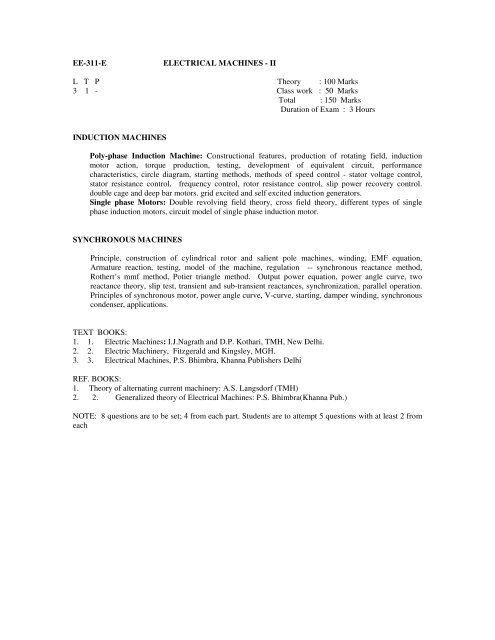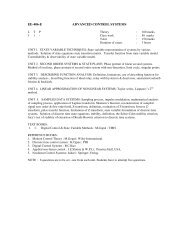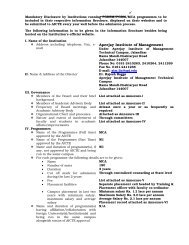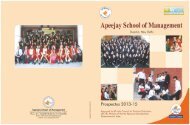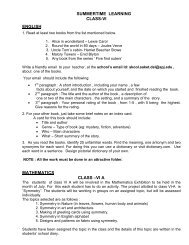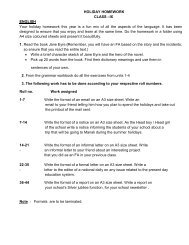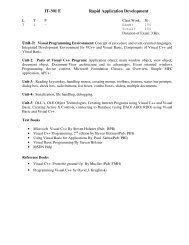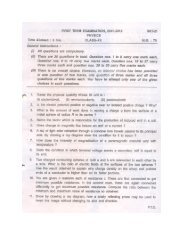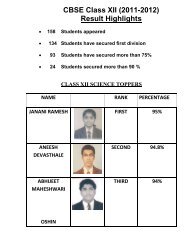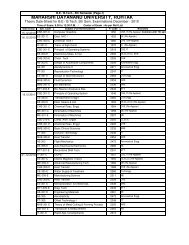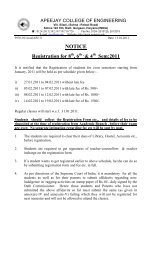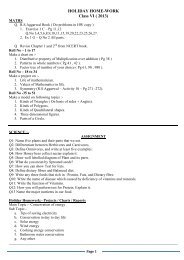EE-311-E ELECTRICAL MACHINES - II L T P Theory : 100 ...
EE-311-E ELECTRICAL MACHINES - II L T P Theory : 100 ...
EE-311-E ELECTRICAL MACHINES - II L T P Theory : 100 ...
- No tags were found...
Create successful ePaper yourself
Turn your PDF publications into a flip-book with our unique Google optimized e-Paper software.
<strong>EE</strong>-303-<strong>EE</strong>LECTRONIC MEASUREMENT AND INSTRUMENTATIONL T P CLASS WORK : 503 1 0 EXAM : <strong>100</strong>TOTAL : 150DURATION OF EXAM : 3 HRSUNIT 1. OSCILLOSCOPE:Block diagram, study of various stages in brief, high frequency CRO considerations. Sampling and storageoscilloscope.UNIT 2. ELECTRONIC INSTRUMENTS:Instruments for measurement of voltage, current & other circuit parameters, Q-meters, R.F. powermeasurements, introduction to digital meters.UNIT 3. GENERATION & ANALYSIS OF WAVEFORMS:Block diagram of pulse generators, signal generators, function generators wave analysers, distortionanalysers, spectrum analyser, Harmonic analyser, introduction to power analyser.UNIT 4. FREQUENCY & TIME MEASUREMENT:Study of decade counting Assembly(DCA), frequency measurements, period measurements, universalcounter, introduction to digital meters.UNIT 5. DISPLAY DEVICES:Nixie tubes, LED’s LCD’s, discharge devices.UNIT 6 TRANSDUCERS:Classification, Transducers of types: RLC photocell, thermocouples etc. basic schemes of measurement ofdisplacement, velocity, acceleration, strain, pressure, liquid level & temperature.UNIT 7 INTRODUCTION TO SIGNAL CONDITIONING:DC signal conditioning system, AC signal conditioning system, data acquisition and conversion systemTEXT BOOK:1. 1. A course in Electrical & Electronics Measurements & Instrumentation : A.K.Sawhney; DhanpatRai & Sons.REFERENCE BOOKS.1. 1. Electronics Instrumentation & Measurement Techniques : Cooper; PHI.NOTE: Eight questions are to be set – at least one from each unit. Students have to attempt five questionsin all.
<strong>EE</strong>-315-EPOWER SYSTEMS-IL T P <strong>Theory</strong> :<strong>100</strong> Marks3 1 - Class work :50 MarksTotal:150 MarksDuration of Exam :3 Hrs.1. 1. INTRODUCTION: Structure of a power system, indoor and outdoor substations, equipment forsubstations, layout, auxiliary supply.2. 2. DISTRIBUTION SYSTEMS: Radial, ring mains and network distribution system, comparison ofvarious types of ac and dc systems.3. 3. TRANSMISSION LINES: Calculation of line parameters, Ferranti effect, proximity effect.4. 4. PERFORMANCE OF LINES: models of short, medium and long transmission lines, performanceof transmission lines, circle diagram, capacity of synchronous condenser, tuned lines, voltage control.5. 5. MECHANICAL DESIGN: Sag and stress calculations, effect of ice and wind, dampers.6. 6. INSULATORS: Types, insulating materials, voltage distribution over insulator string, equalizerring.7. 7. CABLES: Types of LV and HV cables, grading of cables, capacitance, ratings.8. 8. CORONA: Phenomenon, critical voltage, power loss, reduction in losses, radio-interference,HVDC transmission – types of links, advantages and limitations.TEXT BOOKS: 1. Power System Engg: I.J.Nagrath and D.P.Kothari (TMH)2. A Course in Electrical Power: Gupta, Soni & Bhatnagar (Dhanpat Rai & Sons).REF. BOOKS:1. Elements of power system analysis: W.D.Stevenson (MGH)2. Electric Power: S.L.Uppal (Khanna Pub.)3. Electrical power: J.B.Gupta ( S.K.Kataria & Sons).4. Power System Engineering: B. R. Gupta.5. Electric Power System: B.M.Weedy, John Wiley & Sons.6. Transmission & Distribution of Electrical Engineering: H.Cotton.7. 7. Transmission & Distribution of Electrical Engineering: Westing House & Oxford Univ. Press,New Delhi.NOTE: 8 questions are to be set –one from each unit. Students have to attempt any 5 questions.<strong>EE</strong>-317-EPOWER ELECTRONICSL T P CLASS WORK : 503 1 0 EXAM : <strong>100</strong>TOTAL : 150DURATION OF EXAM : 3 HRSUNIT1. INTRODUCTION :Role of power electronics, review of construction and characteristics of power diode, Shottky diode, powertransistor, power MOSFET, SCR, DIAC, Triac, GTO, IGBT & SIT.UNIT2. SCR:Ratings and protections, series and parallel connections, R, RC and UJT firing circuit and other firingcircuits based on ICs and microprocessors; pulse transformer and opto-coupler, commutation techniques.UNIT3. AC REGULATORS:Types of regulator, equation of load current, calculation of extinction angle, output voltage equation,harmonics in load voltage and synchronous tap changer, three phase regulator.
<strong>EE</strong>-313-EMICROPROCESSOR (8085), INTERFACING & APPLICATIONSL T P <strong>Theory</strong> : <strong>100</strong> marks3 1 - Class Work : 50 marksTotal : 150 marksDuration of Exam. : 3 Hrs.1. Introduction: Overview; History of microprocessors.2. The 8085 Processor: Architecture, Addressing modes, instruction set, Timing diagrams & simpleexamples, including loops & nested loops, interrupts.3. The 8255 PPI chip: Architecture, control words, modes & simple examples.4. Introduction to other chips: Introduction to DMA process & its controller chip 8257, & a few otherchip such as programmable interrupt controller, programmable interval timer.5. Interfacing & application of 8085 Microprocessor: Interfacing issues, Interfacing ADC & DAC,Interfacing memory, Microprocessor-based voltage, current, frequency, power measurementschemes.TEXT BOOKS:1. Ramesh S. Gaonkar, “Microprocessor Architecture, Programming & Applications with 8085/8086A”, Wiley Eastern Ltd.REF. BOOKS:1. B.Ram, “Fundamentals of Microprocessors & Microcomputers”, Dhanpat Rai & Sons, Delhi.2. Michael Andrews, “Programming Microprocessor Interfaces for control & instrumentation”,Prentice Hall Inc., Engle Wood Clifs, New Jersey.3. S.I. Ahson, “Microprocessors with Application in Process Control”, TMH, New Delhi.Note: 8 question are to be set, at least one question from each unit. Students have to attempt any 5questions.<strong>EE</strong>-323-<strong>EE</strong>LECTRONIC MEASUREMENT AND INSTRUMENTATION-LABL T P CLASS WORK : 250 0 2 EXAM : 25TOTAL : 50DURATION OF EXAM : 3 HRSLIST OF EXPERIMENTS:1. Measurement of displacement using LVDT.2. Measurement of distance using LDR.3. Measurement of temperature using R.T.D.4. Measurement of temperature using Thermocouple.5. Measurement of pressure using Strain Guage.6. Measurement of pressure using Piezo-Electric Pick up.7. Measurement of distance using Capacitive Pick up.8. Measurement of distance using Inductive Pick up.9. Measurement of speed of DC Motor using Magnetic Pick up.10. Measurement of speed of DC Motor using Photo Electric Pick up.
NOTE : 1. At least ten experiments have to be performed in the semester.2. At least seven experiments should be performed from above list. Remaining three experimentsmayeither be performed from the above list or designed & set by the concerned institution as perthe scopeof the syllabus of <strong>EE</strong>-303-C.<strong>EE</strong>-321-EPOWER ELECTRONICS-LABL T P CLASS WORK : 250 0 2 EXAM : 25TOTAL : 50DURATION OF EXAM : 3 HRSLIST OF EXPERIMENTS:1. 1. Study of characteristics of diode, thyristor and triac.2. 2. Study of characteristics of transistor and MOSFET.3. 3. Study of R and R-C firing circuits.4. 4. Study of UJT firing circuit.5. 5. Study of complementary voltage commutation using a lamp flasher.6. 6. Study of complementary voltage commutation using ring counter.7. 7. Study of thyristorised d-c circuit breaker.8. 8. Study of a.c. phase control.9. 9. Study of full wave converter.10. 10. Study of dc chopper.11. 11. Study of series inverter.12. 12. Study of bridge inverter.13. 13. Study of single phase cycloconverter.NOTE : At least ten experiments have to be performed in the semester. At least seven experiments shouldbe performed from above list. Remaining three experiments may either be performed from the above list ordesigned & set by the concerned institution as per the scope of the syllabus of <strong>EE</strong>-308-C.


